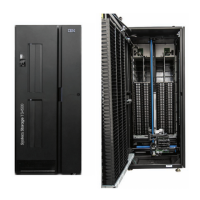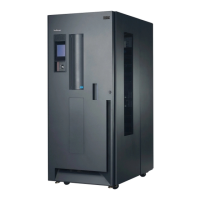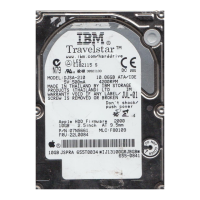Metro Mirror copying supports a maximum distance of 300 km (186 mi). Delays in
response times for Metro Mirror are proportional to the distance between the
volumes. However, 100% of the source data is available at the recovery when the
copy operation ends.
The following procedure describes how data is written for a Remote Mirror and
Copy operation. A copy to the target storage unit is synchronous with the source
volume‘s I/O operation.
1. An application requests a write I/O to the source storage unit. The write I/O is
written into cache and nonvolatile storage (NVS).
2. Metro Mirror sends the write I/O to the target storage unit cache and NVS.
3. The storage unit at the recovery site signals that the write operation has
completed when the updated data is in its cache and NVS.
4. When the storage unit at the production site receives notification from the target
storage unit that the write operation has completed, it returns the I/O completed
status to your application.
Consistency groups
Consistency groups are used for controlling error situations and for maintaining data
consistency at a recovery site.
You can create paths from a source LSS to a target LSS have the consistency
group option enabled. All volume pairs in remote mirror and copy relationships from
this source to target LSS (sharing the same paths) belong to the consistency group.
Other volumes pairs are not affected.
With the consistency group option enabled, when an error occurs on any volume
pairs or on the links that are associated with these LSS pairs, an alert is issued and
I/O to all duplex remote mirror and copy volumes on LSS pairs will be queued
either until a consistency group created operation is run or the consistency group
timeout time expires, allowing external automation to use the consistency group
created operation to create a dependent write consistent set of target volumes over
any number of LSS and disk storage units.
External automation or command-line interface commands can issue a ″freeze″ to
all LSS pairs that relate to the application, affecting the set of source volumes in the
consistency group. The freeze operation causes the source volumes to suspend
and their associated paths to end. Therefore, all associated updates at the recovery
site are halted, resulting in a consistent data checkpoint. The automation program is
not a part of the software provided with the storage unit; it must be supplied by the
user. However, IBM has offerings to assist with this automation. For more
information, contact your IBM storage representative.
A consistency grouping timeout function gives automation software the time to issue
the automated requests to ensure consistency. The consistency grouping timeout is
a value that specifies the length of time that the volume remains in long-busy
(unavailable) following an error. You can change this value by accessing Copy
Services functions from the Web interface (DS Storage Manager ) and navigating to
the Paths page and then to the LSS options page. The default value for this
parameter is set to two minutes.
Note: The consistency group option is not required for Global Mirror or for Global
Copy. Global Copy always keeps a inconsistent copy of the volumes at the
recovery site. The volume pairs become consistent only when all updates
122 DS8000 User’s Guide
